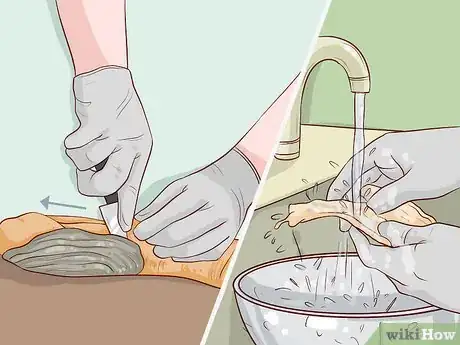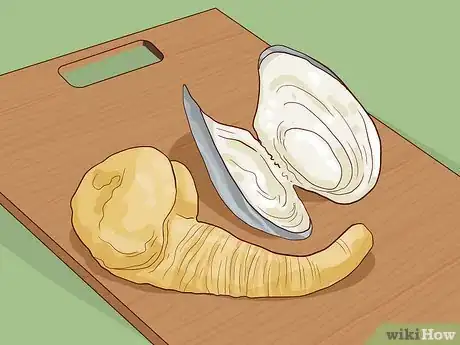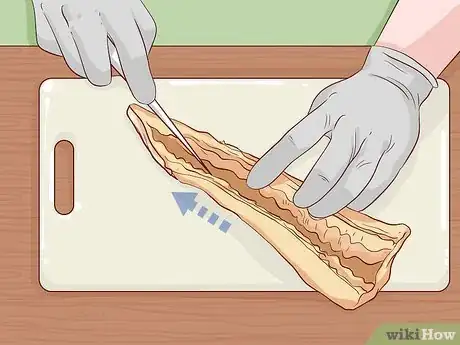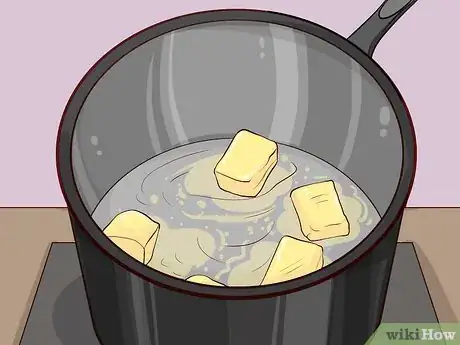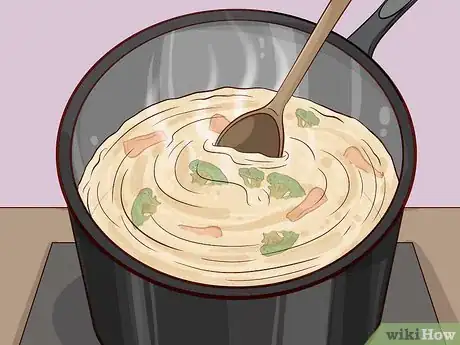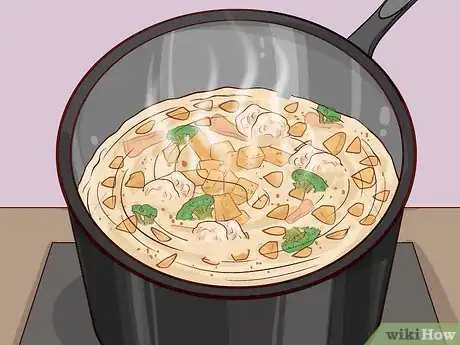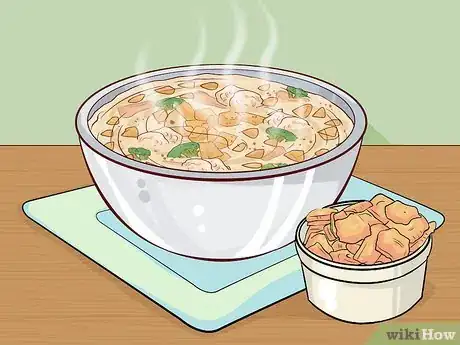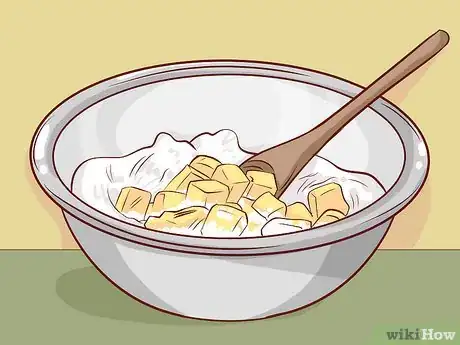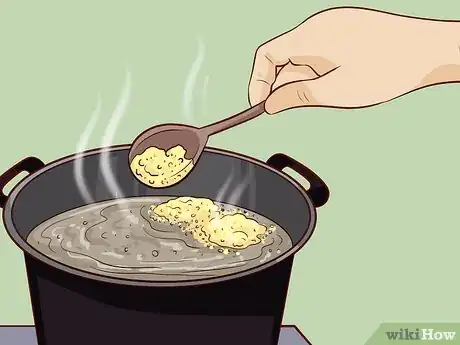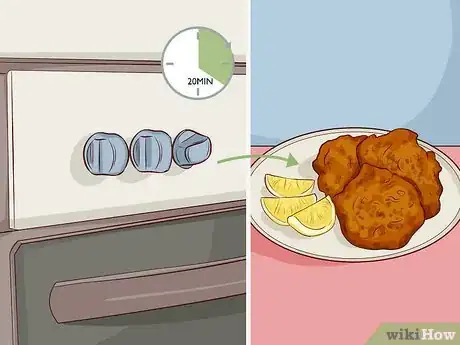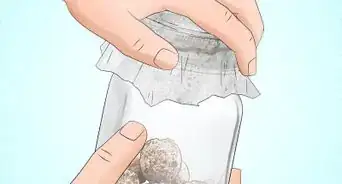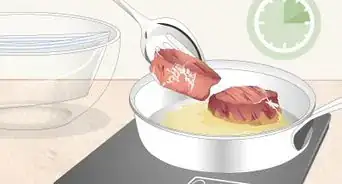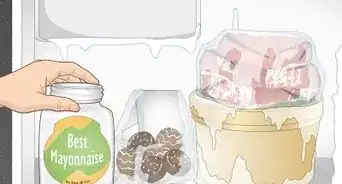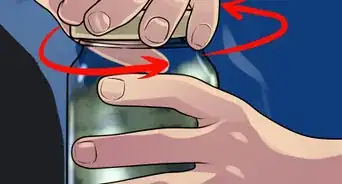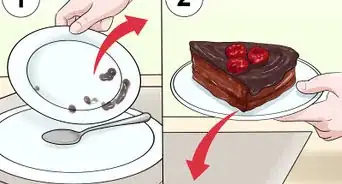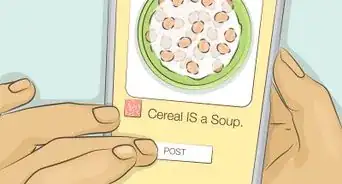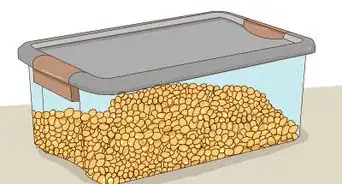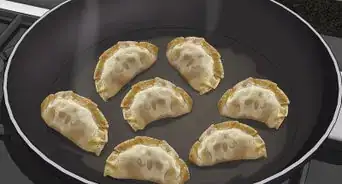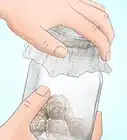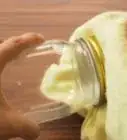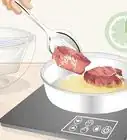This article was co-authored by Daniel Siriban. Daniel Siriban is a Japanese Personal Chef and the Owner of Roshi Experience. With over 18 years of culinary experience, he specializes in sushi, teppanyaki, and traditional Japanese dining. Daniel holds an AA in Restaurant, Culinary, and Catering Management from The Art Institute of California, Orange County.
There are 14 references cited in this article, which can be found at the bottom of the page.
This article has been viewed 29,007 times.
The oddly named and even odder-looking clam called the geoduck (pronounced GOO-ee-duck) is considered a delicacy. The pricey, mild-flavored mollusk is primarily found in the Pacific Northwest and Asia, and like other types of clams can be prepared a number of ways, including simmered in a chowder or fried into crispy fritters. A good fishmonger can clean the massive bivalves for you before you take them home.
Ingredients
- 2 cups (280 g) diced celeriac
- 1 cup (140 g) diced parsnip
- 1 cup (140 g) diced celery
- 1 cup (140 g) diced onion
- 3 cups (140 g) diced Yukon gold potatoes peeled
- 1 cup (140 g) turnip
- 6 Tbsp (85g) butter
- 1 Tbsp (14 g) minced garlic
- 1/2 cup (70 g) all-purpose flour
- 5 cups (1.2 L) clam stock
- 3 cups (710 mL) heavy cream
- 3 lbs. (1.4 kg) geoduck
- 3 tsp (9.9 mL) salt and pepper, to taste
- 1/4 tsp (1 g) cayenne pepper
- 4 tbsp (14 g) fresh parsley
- 1 cup (140 g) flour
- 1 tsp (4 g) baking powder
- 1/2 tsp (2 g) salt
- 1/8 tsp (0.5 g) pepper
- 1/3 cup (75mL) clam juice
- 2 eggs, beaten
- 1/3 cup (75 mL) milk
- 2 tsp (9.9 mL) butter, melted
- 1 geoduck, cleaned and diced
- Vegetable oil
- Lemon wedges
Steps
Cleaning the Meat
-
1Fill a large pot with water, and bring it to a boil. Use a pot that’s large enough to hold enough water to cover an entire geoduck. Turn the burner on high. Covering it will bring it to a boil faster. Nonetheless, boiling times vary.[2]
- The average size of a geoduck is 2.07 lbs (0.94 kg) and the siphon can be as long as a baseball bat!
-
2Lower a geoduck into the boiling water for 10 seconds, then ice it. Use gloves and a pair of long tongs to avoid getting splashed by the water. Use the tongs to remove the clam from the water. Put the geoduck straight into a bowl of ice water to cool it down and stop it from cooking.Advertisement
-
3Use a knife to open the shell, then rinse it with water. Once the geoduck has cooled enough to handle, remove it from the ice bath. Run a thin knife around the edge of the geoduck to cut the muscle that holds the halves together.[3] Use your fingers to pry the two halves apart. When it’s open, rinse under cold water.
- Keep the gloves on for this step, too. In addition to the knife, mollusk shells can be incredibly sharp!
-
4
-
5Cut the meat off the shell. Lift the meat and see where it attaches to the inside of the shell. Slide a sharp knife under the clam meat and carefully run it back and forth. [6]
-
6Slice the siphon lengthwise, then rinse it and trim off the tip. Lay the siphon onto a clean cutting board. Use the knife to slice it lengthwise, right down the middle. The tip of the siphon is generally pretty gross, so slice off whatever feels too tough. Rinse the halves well under cold water.
Making a Geoduck Chowder
-
1Melt the butter in a stock pot over medium heat. Place a large stock pot, which is a large pot used to make stock, on a burner and turn the burner to medium. Drop the butter into the pot and stir when it’s completely melted.[7]
-
2Soften the root vegetables and garlic in the butter for 5-10 minutes. Softening, or sweating, vegetables is when you cook them at a lower heat in a small amount of fat so that they’re, yes, softer. The trick is to make them soft without browning them, about 5-10 minutes.[8]
-
3Add the flour slowly and stir until it’s all absorbed, then add the clam stock. Stir it slowly so that lumps don’t form. Flour is a starch, and starches are a great way to thicken soup. [9] Cook until all the flour has been absorbed. Slowly add the clam stock and bring this mixture to a simmer
-
4Add the potatoes and stir until they’re soft. Another starch, potatoes are often used in chowders as a thickener.[10] Stir occasionally until the potatoes are soft.
-
5Add the cream, the spices and the geoduck, and simmer. Simmer for the soup for another five minutes. Add the parsley.
-
6Serve with oyster crackers. These small round crackers are a traditional chowder sidekick. Drop them in the soup and they’ll soak up all the flavors into one bite![11]
Frying Geoduck Fritters
-
1Preheat your oven to 200 degrees F (93 C) for later. Even though you’re not going to cook the fritters in the oven, you should have it warmed up so that when the fritters are done, you can place them inside to keep them warm. While you’re at it, line a baking dish with paper towels and set it aside.[12]
-
2Mix the dry ingredients. Combine the flour, the baking powder, the salt, and the pepper together in a large bowl. You can use a simple fork to mix them together. Then, with a spatula, make a small indentation or well.[13]
-
3Mix the wet ingredients, and add to the dry ingredients. Whisk together in another large bowl the clam juice, eggs, and milk. Slowly add the wet mixture, using a spatula to combine it a little at a time. Scrape the sides and bottom to make sure everything is mixed.[14]
-
4Fold in the butter and geoduck meat. Folding, in cooking, means adding an ingredient slowly so air doesn’t get in. The best tools for folding are rubber spatulas and large spoons.[15]
-
5Heat up the oil to 375 degrees F (190 C). Fill a large sauce pan or wok to the halfway point with vegetable oil. Vegetable oil has a high smoke point, which means it will take a while before it gets too hot and starts to smoke.[16] Heat the oil to 375 degrees F (190 C), using a thermometer to check.
-
6Drop in spoonfuls of batter one by one, and cook for 3-4 minutes each. Slowly drop large spoonfuls of batter into the hot oil. Allow each fritter to cook for 3-4 minutes each, turning once, or until the fritters are golden brown. Never crowd your fritters![17]
-
7Move the fritters to the preheated oven. Drain the fritters with paper towels, and then put them onto the baking sheet. Put the fritters in the preheated oven to keep them warm for up to 20 minutes.[18] Serve as soon as you can, with a garnish of lemon wedges.
Expert Q&A
-
QuestionHow do you clean a geoduck's stomach?
 Daniel SiribanDaniel Siriban is a Japanese Personal Chef and the Owner of Roshi Experience. With over 18 years of culinary experience, he specializes in sushi, teppanyaki, and traditional Japanese dining. Daniel holds an AA in Restaurant, Culinary, and Catering Management from The Art Institute of California, Orange County.
Daniel SiribanDaniel Siriban is a Japanese Personal Chef and the Owner of Roshi Experience. With over 18 years of culinary experience, he specializes in sushi, teppanyaki, and traditional Japanese dining. Daniel holds an AA in Restaurant, Culinary, and Catering Management from The Art Institute of California, Orange County.
Japanese Personal Chef After boiling and cleaning the skin, submerge it in water with salt. Then, cut it in half to remove all the innards before serving.
After boiling and cleaning the skin, submerge it in water with salt. Then, cut it in half to remove all the innards before serving.
References
- ↑ https://www.opb.org/news/article/how-to-cook-a-geoduck/
- ↑ https://www.geniuskitchen.com/recipe/how-to-boil-water-445229
- ↑ Daniel Siriban. Japanese Personal Chef. Expert Interview. 1 September 2021.
- ↑ Daniel Siriban. Japanese Personal Chef. Expert Interview. 1 September 2021.
- ↑ https://www.finecooking.com/recipe/geoduck-carpaccio
- ↑ https://honest-food.net/how-to-clean-gaper-horse-clam/
- ↑ https://www.dairygoodness.ca/butter/butter-tips-tricks/how-to-melt-butter
- ↑ https://www.reluctantgourmet.com/how-to-sweat-vegetables/
- ↑ https://www.thekitchn.com/soups-on-7-ways-to-make-any-so-106057
- ↑ http://dish.allrecipes.com/how-to-make-chowder/
- ↑ http://dish.allrecipes.com/how-to-make-chowder/
- ↑ https://food.unl.edu/keeping-foods-warm-while-other-foods-get-done
- ↑ https://www.bhg.com/recipes/how-to/cooking-basics/how-to-combine-wet-dry-ingredients/
- ↑ https://www.bhg.com/recipes/how-to/cooking-basics/how-to-combine-wet-dry-ingredients/
- ↑ https://www.taste.com.au/baking/articles/how-to-fold-ingredients/bfczqmgw
- ↑ https://www.bonappetit.com/story/best-oil-for-frying
- ↑ https://www.today.com/food/10-tips-deep-frying-home-pro-fried-chicken-candy-bars-t77996
- ↑ https://food.unl.edu/keeping-foods-warm-while-other-foods-get-done


